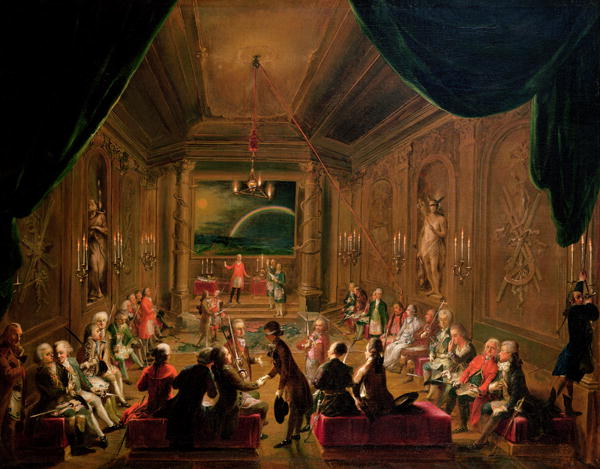Mesoteric or Masonic Level of Interpretation
| The oil painting,
shown at the right, was probably completed in about the year 1789 by an
artist named Ignaz
Unterberger. It is now on display in the
Historical Museum of the City of Vienna. The painting shows the inside
of what is thought to be the Crowned Hope Lodge in Vienna. There has
been much discussion about the identities of some of the lodge members
shown in the painting. It is believed that Mozart is depicted at the
extreme right, sitting next to his close friend Emanuel Schikaneder
(1751-1812). Also, the
young actor, playwright and mineralogist Karl Ludwig Giesecke
(1761-1833) may be the
fifth figure from the front left (seated). Both Schikaneder and Giesecke
were involved in writing the libretto for Die Zauberflöte. The Master of
Ceremonies is Prince Nicolaus Esterházy (1714-1790), the principal patron of Joseph Haydn.
This painting contains several symbols
pertaining to both Freemasonry and alchemy.
On the back wall is a large painting
showing the setting sun and a rainbow. In Freemasonry the rainbow was a
symbol of purity. The Freemasons always met at night after the sun had
set.
The two columns
at the far end of the lodge are decorated by a climbing snake or serpent
carved on each column. The column on the right is the lunar pillar
associated with salt. The column on the left is the solar pillar
associated with the substance Sulphur. These two pillars are also
associated the brass pillars of the Temple of Solomon in Jerusalem cited
in the Bible at 1 Kings 7:21 as follows:
And he set up
the pillars in the porch of the temple: and he set up the right pillar,
and called the name thereof Joachim: 1 and he set up the left pillar,
and called the name thereof Boaz.
The god Mercury (Greek = Hermes; Egyptian =
Thoth) stands in a niche in the right-hand wall of the lodge; in his
right hand he holds a flute and in his left hand he holds his Caduceus
or wand depicting two entwined snakes. The
symbol of snakes coiled around a staff is an ancient representation of
the transformation of consciousness. The staff represents the spinal
column with the snake or snakes being energy channels. In the case of
two entwined snakes, they usually cross each other seven times,
symbolizing the Pythagorean seven-interval octave (Law
of Seven) of psychological
transmutation.
Opposite Mercury, on the
left-hand wall is a statue of the god of the forge, Vulcan (Greek =
Hephaestus; Egyptian = Ptah), who is identifiable by being depicted with
a lame leg and by his hand holding a rising flame. The gods Mercury and Vulcan are commonly associated
with the alchemical arts. Mercury represents with the principle of
feminine moisture and the element water; Vulcan is associated with
Sulphur
principle of masculine dryness and the element fire. |
 |
Wolfgang Mozart petitioned to become a
Freemason in Vienna during the latter part of 1784. He was sponsored by Baron
Otto Freiherr von Gemmingen-Hornberg, Master of the Zur Wohltätigkeit Lodge.
Mozart's name was put before the Lodge on 5 December 1784 and he achieved the
three basic degrees of Masonry on the following dates:
1) Entered Apprentice Degree - 14 December 14 1784
2) Fellow Craft Degree - 07 January 1785
3) Master Mason Degree - Before 22 April 1785
Subsequently, his father, Leopold Mozart, also became a Master Mason in Vienna in
that same year.
There is wide disagreement among historians
concerning Mozart's position within the Masonic movement, particularly with
respect to his relationship with those Masons who were also members or
sympathizers with the Illuminati.
Maynard Solomon has asserted that Mozart
supported the beliefs of the Aufklärung (rational Enlightenment), a
rational, humanist inspired membership, as opposed to those members oriented
toward mysticism and the occult, a movement in German known as the
Erleuchtung. The rationalist faction has been identified with the
Illuminati, a political group which was founded by the Bavarian professor of
canon law, Adam Weishaupt (1748-1830), who was purported to be a friend of
Mozart. The principal political goal of the Illuminati was the abolition of all
monarchical governments and state religions in Europe and its colonies.
The Illuminati espoused the rational, humanist
views proposed by the French philosophers Jean-Jacques Rousseau and Denis
Diderot. The Illuminati contended that social rank was not coincident with
nobility of the spirit, but that people of lower social status could be noble in
spirit just as nobly born people could be mean-spirited. This view appears in
Mozart's operas; for example, in The Marriage of Figaro, an opera based
on a play by Pierre Beaumarchais (another Freemason), the lowly-born Figaro is
the hero and the Count Almaviva is the boor.
Other scholars and historians, such as M. F. M.
van den Berk, contend that Mozart was more closely associated with the
Erleuchtung (mystical Enlightenment). This movement was more closely
associated with the Rosicrucians and mainly was concerned with the achievement
of higher states of human consciousness.
My personal research in this matter is still in
progress. Mozart had strong connections with both groups and his final opera,
Die Zauberflöte may be interpreted with respect to either belief system.
|